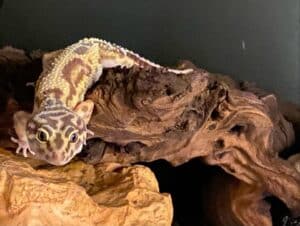Our leopard gecko joined us during our closure, and like others of his species, can be a little shy. Leopard geckos are also widely considered to be nocturnal, so he does spend the majority of the daylight hours in his hide. When he does come out to say hello, you can’t help but notice his distinctive brown and yellow markings. These markings act as camouflage, helping them hide from predators.
The leopard gecko is a ground-dwelling lizard native to the rocky dry grassland and desert regions of Afghanistan, Iran, Pakistan, India, and Nepal. They are thought to be the first species of lizard to be widely domesticated.
The thick tail of the leopard gecko can store fat, acting as an energy reserve when there is not an available food supply. They can also regenerate their tails, which can detach when attacked by predators, but the regenerated tail will never look quite the same as the original.
Unlike other gecko species, leopard geckos do not have toe pads, so they can’t stick to walls and climb like other species can. Also unlike other geckos, they have moveable eyelids.

